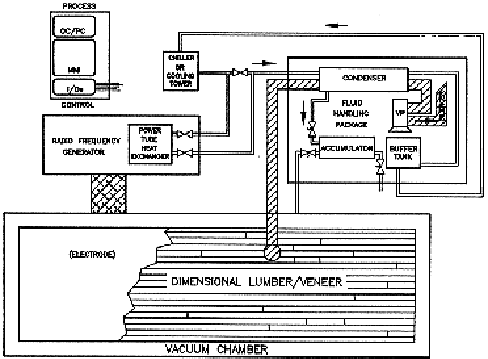
RF Generator power control: By adjusting the power control (plate amperes) via a motorized variable capacitor, the output of the RF generator is increased or decreased. In this way, the amount of process heat produced by the generator and delivered into the load is controlled. Computer software effects the proper process balance based on templates.
Vacuum control: By adjusting the vacuum inside the chamber, the amount of water evaporation is controlled. The vacuum pump speed is varied by a frequency control on the motor varying the rate of vacuum increase. The chamber is vented by a motorized valve to decrease the vacuum. Vapor condensation is achieved through a chilled water loop (which may utilize a chiller, or cooling tower, or ground water loop via a tube and shell heat exchanger).
Wood Temperature Control: The interior wood temperature is a critical variable for following the optimum drying cycle for a given species. Probes placed at four intervals in the wood load feed values to the PC to set the best drying rate. These values may be averaged (and/or weighted) for control function.
The combination of RF heat, vacuum adjustments and temperature measurements throughout the drying cycle yield the desired rate of drying according to the template. This rate is indicated by the amount of water extracted and moisture content change in the load over time.
Wood Moisture Extraction: The speed by which the water is removed by the processes above is monitored and precisely measured for each drying cycle. Depending on the species, roughly one-half of the weight of the undried lumber is removed during the drying cycle.

